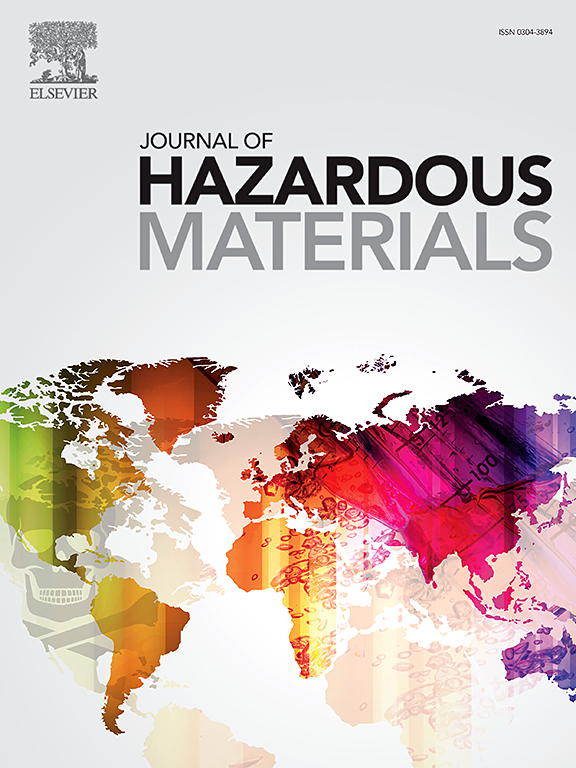Mechanistic Understanding of Copper (Cu) Mobility in Aged Biochar: Influence of Dissolved Organic Matters Release and Oxygen-Containing Groups
IF 11.3
1区 环境科学与生态学
Q1 ENGINEERING, ENVIRONMENTAL
引用次数: 0
Abstract
The long-term behavior of copper (Cu) in biochar-amended soils is not well understood, particularly concerning the role of dissolved organic matter (DOM) and oxygen-containing functional groups formed during biochar aging. This study hypothesizes that aging-induced release of DOM and surface oxidation, both influenced by pyrolysis temperature, differentially affect Cu mobility in soil systems. To test this, biochars were produced from granular anaerobic sludge, coffee grounds, and rice straw at 300°C and 700°C, and applied as both biochar solid and aqueous extracts to Cu-contaminated soil and synthetic model soils with Cu-adsorbed ferrihydrite or hematite. Low-temperature biochar extracts (LDOM) significantly increased Cu mobility, with pore water concentrations rising from 0.7–2.8 mg/L (1 day) to 11.9–19.6 mg/L (28 days), while high-temperature biochar extracts (HDOM) showed no Cu solubilization. LDOM mobilized Cu from crystalline hematite but not from ferrihydrite, while HDOM transformed Cu into more stable oxidizable forms. Aged biochars exhibited enhanced Cu adsorption due to the formation of surface O-functional groups, although DOM released from biochar decreased adsorption efficiency. Surface complexation modeling supported these trends, indicating increased binding affinity after aging. This study demonstrates that biochar aging significantly alters Cu behavior in soil, depending on the interplay between DOM release and surface chemistry, which are both dictated by the original pyrolysis temperature. This has potential applications in heavy metal remediation and sustainable soil management practices, offering a strategy for mitigating Cu contamination in agricultural and environmental settings.

老化生物炭中铜(Cu)迁移的机理:溶解有机质释放和含氧基团的影响
铜(Cu)在生物炭改性土壤中的长期行为尚不清楚,特别是关于生物炭老化过程中溶解有机物(DOM)和含氧官能团的作用。本研究假设老化引起的DOM释放和表面氧化均受热解温度的影响,对土壤系统中的Cu迁移率有不同的影响。为了验证这一点,在300°C和700°C的条件下,从颗粒厌氧污泥、咖啡渣和稻草中产生生物炭,并将生物炭固体和水提取物应用于cu污染土壤和含cu吸附的水合铁或赤铁矿的合成模型土壤。低温生物炭提取物(LDOM)显著提高了铜的迁移率,孔隙水浓度从0.7 ~ 2.8 mg/L (1 d)上升到11.9 ~ 19.6 mg/L (28 d),而高温生物炭提取物(HDOM)没有铜的增溶作用。LDOM能从结晶赤铁矿中调动铜,但不能从水合铁中调动铜,而HDOM能将铜转化为更稳定的可氧化形式。老化后的生物炭由于表面o官能团的形成而增强了对Cu的吸附,但生物炭释放的DOM降低了吸附效率。表面络合模型支持这些趋势,表明老化后结合亲和力增加。该研究表明,生物炭老化显著改变了土壤中Cu的行为,这取决于DOM释放和表面化学之间的相互作用,而这两者都由原始热解温度决定。这在重金属修复和可持续土壤管理实践中有潜在的应用,为减轻农业和环境环境中的铜污染提供了一种战略。
本文章由计算机程序翻译,如有差异,请以英文原文为准。
求助全文
约1分钟内获得全文
求助全文
来源期刊

Journal of Hazardous Materials
工程技术-工程:环境
CiteScore
25.40
自引率
5.90%
发文量
3059
审稿时长
58 days
期刊介绍:
The Journal of Hazardous Materials serves as a global platform for promoting cutting-edge research in the field of Environmental Science and Engineering. Our publication features a wide range of articles, including full-length research papers, review articles, and perspectives, with the aim of enhancing our understanding of the dangers and risks associated with various materials concerning public health and the environment. It is important to note that the term "environmental contaminants" refers specifically to substances that pose hazardous effects through contamination, while excluding those that do not have such impacts on the environment or human health. Moreover, we emphasize the distinction between wastes and hazardous materials in order to provide further clarity on the scope of the journal. We have a keen interest in exploring specific compounds and microbial agents that have adverse effects on the environment.
 求助内容:
求助内容: 应助结果提醒方式:
应助结果提醒方式:


